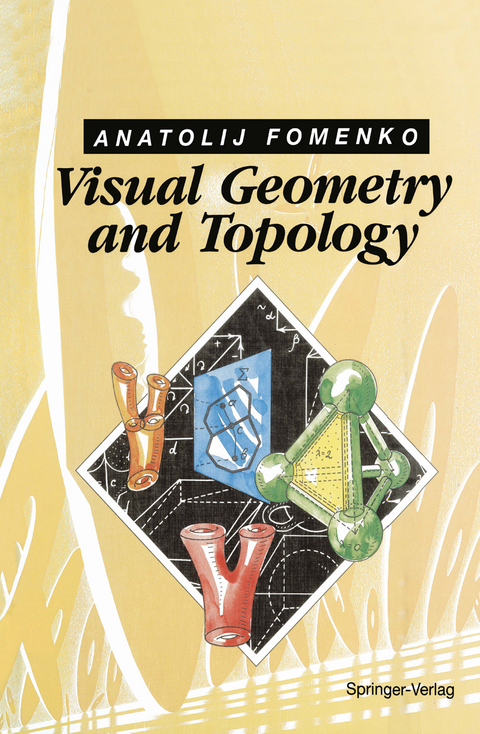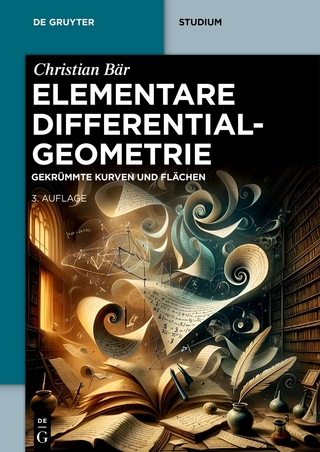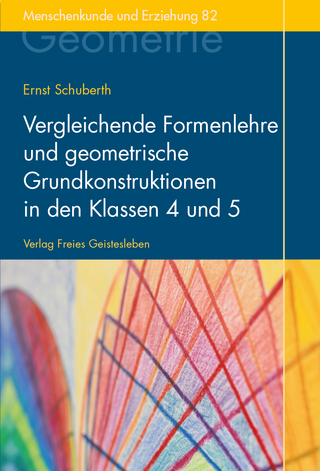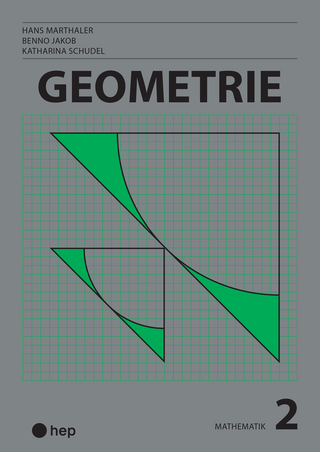
Visual Geometry and Topology
Springer Berlin (Verlag)
978-3-642-76237-6 (ISBN)
1 Polyhedra. Simplicial Complexes. Homologies.- 1.1 Polyhedra.- 1.1.1 Introductory Remarks.- 1.1.2 The Concept of an n-Dimensional Simplex Barycentric Coordinates.- 1.1.3 Polyhedra. Simplicial Subdivisions of Polyhedra. Simplicial Complexes.- 1.1.4 Examples of Polyhedra.- 1.1.5 Barycentric Subdivision.- 1.1.6 Visual Material.- 1.2 Simplicial Homology Groups of Simplicial Complexes (Polyhedra).- 1.2.1 Simplicial Chains.- 1.2.2 Chain Boundary.- 1.2.3 The Simplest Properties of the Boundary Operator Cycles. Boundaries.- 1.2.4 Examples of Calculations of the Boundary Operator.- 1.2.5 Simplicial Homology Groups.- 1.2.6 Examples of Calculations of Homology Groups. Homologies of Two-dimensional Surfaces.- 1.2.7 Visual Material.- 1.3 General Properties of Simplicial Homology Groups.- 1.3.1 Incidence Matrices.- 1.3.2 The Method of Calculation of Homology Groups Using Incidence Matrices.- 1.3.3 "Traces" of Cell Homologies Inside Simplicial Ones.- 1.3.4 Chain Homotopy. Independence of Simplicial Homologies of a Polyhedron of the Choice of Triangulation.- 1.3.5 Visual Material.- 2 Low-Dimensional Manifolds.- 2.1 Basic Concepts of Differential Geometry.- 2.1.1 Coordinates in a Region. Transformations of Curvilinear Coordinates.- 2.1.2 The Concept of a Manifold. Smooth Manifolds. Submanifolds and Ways of Defining Them. Manifolds with Boundary. Tangent Space and Tangent Bundle.- 2.1.3 Orientability and Non-Orientability. The Differential of a Mapping. Regular Values and Regular Points. Embeddings and Immersions of Manifolds. Critical Points of Smooth Functions on Manifolds. Index of Nondegenerate Critical Points and Morse Functions.- 2.1.4 Vector and Covector Fields. Integral Trajectories. Vector Field Commutators. The Lie Algebra of Vector Fields on a Manifold.- 2.1.5 Visual Material.- 2.2 Visual Properties of One-Dimensional Manifolds.- 2.2.1 Isotopies, Frames.- 2.2.2 Visual Material.- 2.3 Visual Properties of Two-Dimensional Manifolds.- 2.3.1 Two-Dimensional Manifolds with Boundary.- 2.3.2 Examples of Two-Dimensional Manifolds.- 2.3.3 Modelling of a Projective Plane in a Three-Dimensional Space.- 2.3.4 Two Series of Two-Dimensional Closed Manifolds.- 2.3.5 Classification of Closed 2-Manifolds.- 2.3.6 Inversion of a Two-Dimensional Sphere.- 2.3.7 Visual Material.- 2.4 Cohomology Groups and Differential Forms.- 2.4.1 Differential 1-Forms on a Smooth Manifold.- 2.4.2 Closed and Exact Forms on a Two-Dimensional Manifold.- 2.4.3 An Important Property of Cohomology Groups.- 2.4.4 Direct Calculation of One-Dimensional Cohomology Groups of One-Dimensional Manifolds.- 2.4.5 Direct Calculation of One-Dimensional Cohomology Groups of a Plane, a Two-Dimensional Sphere and a Torus.- 2.4.6 Direct Calculation of One-Dimensional Cohomology Groups of Oriented Surfaces, i.e. Spheres with Handles.- 2.4.7 An Algorithm for Recognition of Two-Dimensional Manifolds. Elements of Two-Dimensional Computer Geometry.- 2.4.8 Calculation of One-Dimensional Cohomologies of a Surface Using Triangulation.- 2.4.9 Visual Material.- 2.5 Visual Properties of Three-Dimensional Manifolds.- 2.5.1 Heegaard Splittings (or Diagrams).- 2.5.2 Examples of Three-Dimensional Manifolds.- 2.5.3 Equivalence of Heegaard Splittings.- 2.5.4 Spines.- 2.5.5 Special Spines.- 2.5.6 Filtration of 3-Manifolds with Respect to Matveev's Complexity.- 2.5.7 Simplification of Special Spines.- 2.5.8 The Use of Computers in Three-Dimensional Topology. Enumeration of Manifolds in Increasing Order of Complexity.- 2.5.9 Matveev's Complexity of 3-Manifolds and Simplex Glueings.- 2.5.10 Visual Material.- 3 Visual Symplectic Topology and Visual Hamiltonian Mechanics.- 3.1 Some Concepts of Hamiltonian Geometry.- 3.1.1 Hamiltonian Systems on Symplectic Manifolds.- 3.1.2 Involutive Integrals and Liouville Tori.- 3.1.3 Momentum Mapping of an Integrable System.- 3.1.4 Surgery on Liouville Tori at Critical Energy Values.- 3.1.5 Visual Material.- 3.2 Qualitative Questions of Geometric Integration of Some Differential Equations. Classification of Typical Surgeries of Liouville Tori of Integrable Systems with Bott Integrals.- 3.2.1 Nondegenerate (Bott) Integrals.- 3.2.2 Classification of Surgeries of Bott Position on Liouville Tori.- 3.2.3 The Topological Structure of Critical Energy Levels at a Fixed Second Integral.- 3.2.4 Examples from Mechanics. The Equations of Motion of a Rigid Body. The Poisson Sphere. Geometrical Interpretation of Mechanical Systems.- 3.2.5 An Example of an Investigation of a Mechanical System. The Liouville System on the Plane.- 3.2.6 The Liouville System on the Sphere.- 3.2.7 Inertial Motion of a Gyrostat.- 3.2.8 The Case of Chaplygin-Sretensky.- 3.2.9 The Case of Kovalevskaya.- 3.2.10 Visual Material.- 3.3 Three-Dimensional Manifolds and Visual Geometry of Isoenergy Surfaces of Integrable Systems.- 3.3.1 A One-Dimensional Graph as a Hamiltonian Diagram.- 3.3.2 What Familiar Manifolds Are Encountered Among Isoenergy Surfaces?.- 3.3.3 The Simplest Isoenergy Surfaces (with Boundary).- 3.3.4 Any Isoenergy Surface of an Integrable Nondegenerate System Falls into the Sum of Five (or Two) Types of Elementary Bricks.- 3.3.5 New Topological Properties of the Isoenergy Surfaces Class.- 3.3.6 One Example of a Computer Use in Symplectic Topology.- 3.3.7 Visual Material.- 4 Visual Images in Some Other Fields of Geometry and Its Applications.- 4.1 Visual Geometry of Soap Films. Minimal Surfaces.- 4.1.1 Boundaries Between Physical Media. Minimal Surfaces.- 4.1.2 Some Examples of Minimal Surfaces.- 4.1.3 Visual Material.- 4.2 Fractal Geometry and Homeomorphisms.- 4.2.1 Various Concepts of Dimension.- 4.2.2 Fractals.- 4.2.3 Homeomorphisms.- 4.2.4 Visual Material.- 4.3 Visual Computer Geometry in the Number Theory.- Appendix 1 Visual Geometry of Some Natural and Nonholonomic Systems.- 1.1 On Projection of Liouville Tori in Systems with Separation of Variables.- 1.2 What Are Nonholonomic Constraints?.- 1.3 The Variety of Manifolds in the Suslov Problem.- Appendix 2 Visual Hyperbolic Geometry.- 2.1 Discrete Groups and Their Fundamental Region.- 2.2 Discrete Groups Generated by Reflections in the Plane.- 2.3 The Gram Matrix and the Coxeter Scheme.- 2.4 Reflection-Generated Discrete Groups in Space.- 2.5 A Model of the Lobachevskian Plane.- 2.6 Convex Polygons on the Lobachevskian Plane.- 2.7 Coxeter Polygons on the Lobachevskian Plane.- 2.8 Coxeter Polyhedra in the Lobachevskian Space.- 2.9 Discrete Groups of Motions of Lobachevskian Space and Groups of Integer-Valued Automorphisms of Hyperbolic Quadratic Forms.- 2.10 Reflection-Generated Discrete Groups in High-Dimensional Lobachevskian Spaces.- References.
| Erscheint lt. Verlag | 21.12.2011 |
|---|---|
| Übersetzer | M.V. Tsaplina |
| Zusatzinfo | XVI, 324 p. 51 illus. |
| Verlagsort | Berlin |
| Sprache | englisch |
| Maße | 155 x 235 mm |
| Gewicht | 521 g |
| Themenwelt | Mathematik / Informatik ► Mathematik ► Geometrie / Topologie |
| Naturwissenschaften ► Physik / Astronomie | |
| Schlagworte | Hamiltonian systems • Hamiltonsche Systeme • Integrable Systems • Integrierbare Systeme • Mathematical Physics • Topology • Visual Geometry • Visual Topology • Visuelle Geometrie • Visuelle Topologie |
| ISBN-10 | 3-642-76237-9 / 3642762379 |
| ISBN-13 | 978-3-642-76237-6 / 9783642762376 |
| Zustand | Neuware |
| Haben Sie eine Frage zum Produkt? |
aus dem Bereich


